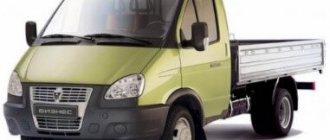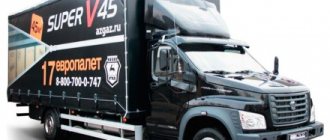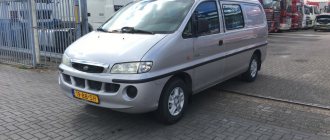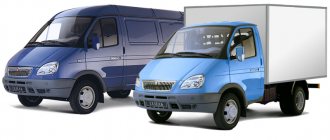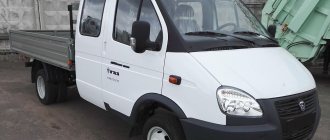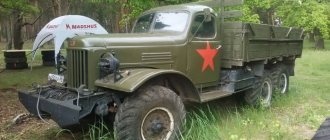The cargo transportation market is developing at a rapid pace. Due to this, the number of commercial vehicles is increasing significantly. If we talk about the Russian market, the GAZelle can rightfully be considered the most popular light-duty truck. This machine has been produced since the mid-90s. At the moment, the Gorky Automobile Plant is producing a new series of trucks. This is “GAZelle Next”, which literally means next in English. The machine has been in mass production since 2013. What is GAZelle Next? Review, technical specifications and much more - further in our article.
Cabin
Let's start our acquaintance with the cockpit. She has undergone a lot of changes. First of all, it is worth noting the fact that the Next’s cabin has become wider than that of the old GAZelle. This is a big plus - now there is much more space inside. The design itself has also changed. The car received a large V-shaped grille and diamond-shaped headlights. The side doors have also changed. The car uses plastic fenders. The mirrors have also changed. They have become larger and more informative.
But there are some drawbacks to this cabin. Thus, reviews raise criticism regarding the radiator grille. It does not have small honeycombs and all insects go straight into the radiator. It becomes clogged and the system does not cool the engine well.
Booth
There are countless modifications created on the basis of GAZelle Next. These are short-wheelbase, extended versions, flatbed, tilt, with a sliding roof, refrigerators, all-metal vans, etc.
The dimensions of GAZelle Next may vary. If we take the standard version with a three-meter body, the dimensions of the car are as follows. The length is 5.63 meters, width – 2.09, height – 2.14 meters. Ground clearance is 17 centimeters. The minimum turning radius is 5.6 meters. The dimensions of the GAZelle Next with a long wheelbase can reach eight meters or more. Thus, cargo platforms 4, 5.5 and 6 meters long are installed on the chassis. It can be an all-metal GAZelle Next or with an awning.
A huge advantage is the use of aluminum sides that do not rot. All GAZelle drivers know how quickly the sides of old GAZelles rust. Corrosion is no longer the enemy.
But, unfortunately, this did not happen with every truck. So, these cars are often converted to third parties). This company is engaged in the manufacture of various types of bodies and their installation. However, as reviews note, these booths are highly susceptible to corrosion. This applies to both tented versions and all-metal GAZelle Next. After six months, the paint begins to peel off, and corrosion appears underneath. Not only the frame but also the gate rusts. However, there are no complaints about the functioning of the booth. She will do her job “one hundred percent,” but her appearance will quickly deteriorate, reviews note.
Verdict
To be honest, most buyers in the regions, especially private owners, are unlikely to have an incentive to switch to the GAZelle NN. Still, in Russia they don’t like to overpay, and they are wary of new technologies - God forbid that it breaks down, repairs will cost a pretty penny, and even downtime will bring losses. But those who are looking at imported models after the first GAZelles will definitely pay attention to the new product from the GAZ Group.
“You have to understand that this is the good old GAZelle Next, only deeply redesigned. With a new box, new functionality, new equipment,” says Alexey Shvaikov.
And that's true. Moreover, the entire gentleman’s set, which imported competitors have been equipped with for decades, finally became available in GAZelle NN in 2021. Indeed, progress. In the near future, they promise parking sensors, cameras in blind spots, tire pressure sensors and other amenities that are well known to users of European and Asian LCVs.
But if we put aside the ridicule of the sluggishness of Russian engineers regarding the implementation of modern solutions, then the bottom line is that we get a fairly successful model at a competitive price. The cost of an all-metal van like the one we tested starts from 2,059,100 rubles in the basic configuration (flatbed version - from 1,899,440 rubles).
And, for example, the new Ford Transit is offered for 2,832,000 rubles, the Volkswagen Transporter AllCity L1H1 – for 2,759,000 rubles, and the Crafter – for 2,923,600 rubles. Of course, the GAZelle CMF from the “Next” series can be purchased from dealers for about 1,600,000 rubles, and it will also make a profit, but without such a level of comfort. In general, as the song says: “Think for yourself, decide for yourself whether to have it or not to have it.”
Salon
The interior design has also changed. First of all, it is worth noting the front panel. It is radically different from the previous one. Thus, the center console features round air deflectors with the ability to adjust in different directions, a new heater control unit and a multimedia system. True, the latter is not available in all GAZelle Next trim levels.
The instrument panel has also changed. Odometer – digital. There is also an on-board computer. The steering wheel has changed. Instead of the archaic two-spoke wheel (which dates back to the time of the GAZon 3307), there is a comfortable four-spoke steering wheel. There are various niches for things and small things in the cabin.
The seats have also changed. So, the driver's seat has an armrest and has good lateral support. The seat has become stiffer, which causes less fatigue on long-distance transport. The GAZelle Next has good visibility inside (due to the “captain’s” seating position). The passenger seat is double, designed for two people.
Note that on 2022 models, the gearshift lever has been moved to the front panel. This decision allowed for more efficient use of interior space. Now, if necessary, you can sleep comfortably on the seats - reviews say. Sound insulation has also improved. Standard speakers and electric windows appeared.
In general, the interior of the GAZelle Next cargo truck has become more comfortable, ergonomic and modern. Compared to the old cabin, this is a significant improvement.
This car is equipped with one of two engines. GAZelle Next is equipped with a Chinese Cummins engine and a Russian UMZ. The first unit develops a power of 149 horsepower with a displacement of 2.8 liters. The second has a volume of 2.7 liters. The Ulyanovsk GAZelle Next engine develops a power of 107 horsepower. This unit was called “Evotek”. What do reviews say about these GAZelle Next engines? We will consider the features of each engine separately below.
Exterior of Gazelle Next
The first thing that people even who are far from cars will notice is the original body, which is radically different from the body of earlier models. And now this domestic truck looks very attractive and modern and has already become one of the most popular business truck models in Moscow at https://www.major-truck.ru/model/gaz/gazel-next/.
The car received a new radiator grille, only the logo remained unchanged. The bumper “swelled” even more and occupied almost the entire front part of the car. The head optics are distinguished by modern lines, and LED strips are built into the headlights, which make the face of the car even more interesting. The body kit looks like a logical continuation of the bumper. It also includes a mesh for an additional air intake and 2 round fog lights.
Cummins and its advantages
So, first, let's look at the diesel GAZelle Next. Among the advantages, reviews note the service interval, which is 20 thousand kilometers. As for fuel consumption, this parameter is influenced by several factors. This is the windage of the booth and the weight of the cargo being transported. But no matter how high the booth is, in a city with traffic jams, the diesel GAZelle Next spends no more than 15 liters per hundred. On the highway, this parameter ranges from 12 to 14 liters.
Kak o has the lowest consumption at a speed of 75-80 kilometers per hour. The good news is that the engine starts without problems in cold weather.
"GAZelle Next": Appetite comes while driving
Sympathy arose at first sight: the all-metal GAZelle Next van captivated us with its cheerful color, flexible character, responsiveness and hard work. With comfort, in some places with a breeze, and most importantly - with desire, we covered kilometers around the city and country roads. No fatigue at all, only positive emotions. “Car of the Year in Russia” in the “Vans” category easily proved that it was not by chance that he received this honorary title in 2016; “accident” is not about him at all.
NEXT means next
The appearance of GAZelle Next (the first-born was an on-board vehicle, the production of which began in 2013) in the model line of the Gorky Automobile Plant, in principle, could not be an accident. This is a pattern and a big step forward, just like the birth of the GAZelle once was. By the way, there is something to remember. At the end of the summer of 1994, GAZ, perhaps for the first time in its modern history, invited journalists to the training ground in Berezovaya Poyma, where they showed it in action and drove the onboard GAZ-3302. This was also an event because the press was told in detail about the merits of the heiress of the legendary “one and a half” and what it was needed for. Previously, it was not customary to explain anything - a new product was accepted by default, because nothing else was offered.
And in 1995, the all-metal GAZ-2705 van appeared in cargo and cargo-passenger versions - the dream of individual (and other) entrepreneurs starting their own business. The cars were a little heavy to drive, not like cars, but who paid attention to that then?! Finally, the plant promptly offered a car that was so needed by a market that was just emerging and was already changing before our eyes - that’s what’s important! The number of factory versions began to multiply. Tuning cars began to grow like mushrooms after rain; they began to lengthen it, build on it, and turn the salon into apartments. By the way, this was a whole era in the life of the Russian auto business.
Seemingly distant times were remembered when I got into the GAZelle Next. They couldn’t help but come to mind, because the model showed itself in development, moving far from the “one and a half” of the mid-nineties. The contrast was striking; I felt like I was in a different era. It could come sooner than in twenty years, but who will count the years when they see that the current generation of all-metal vans, which appeared in the fall of 2015, is in no way inferior to their famous foreign classmates, making life better, more qualitative, more meaningful. You get behind the wheel and go, and the car works for you, and not vice versa.
"Your guy"!
The test car turned out to have a very attractive color. The “candy-colored orange petal streamlined baby” came to mind. It’s a pity that this intricately effective phrase, which became the title of a good book, was not invented by me. I understand, I understand... “GAZelle Next” is far from a “miniature” - a large car and very roomy. But I wouldn’t mind the streamlining - single-box cars, although angular in some places, as a rule, get along well with aerodynamics.
Despite the huge radiator grille, large headlights, impressive dimensions (length, width, height, wheelbase - 6207, 2068, 2753, 3745 mm), the all-metal van with a three-seater cabin does not look bulky and awkward. On the contrary, there is liveliness and dynamism in it, given by the large glass area, the steep slope of the windshield, the rapid contours of the side windows, and the relief of the body panels. These profiles start almost from the front bumper and go all the way to the rear, adding lightness and, dare I say it, elegance to the car, which is quite in the spirit of modern automotive fashion.
By the way, the front part up to the hood, and on the sides - up to almost half the height of the wheel arch - is made of black plastic. It looks stylish and, at the same time, this solution is very practical, because if something cracks or splits (after all, this is a workhorse that will have to be loaded and maneuvered, including in narrow spaces, which we have plenty of) , replacing two side sections will cost less than repairing metal elements.
A little more about color. Its brand name is “Red Gold” (there are five other colors), but personally I saw the van as a kind of “orange”. As it turned out a little later, it was catchy. It has been noted: this representative of the citrus culture pleases the eye and lifts the mood, and also the appetite (just by its appearance), which is what happened to me that day. I just enjoyed the car - its behavior, handling, everything in general.
As for the “candy-colored” look... Well, isn’t it “candy”? Created my mood all day! Okay, let’s replace the colorful word with this long combination without “color”: “modern, reliable, efficient, safe, stylish and ergonomic car,” borrowed from the company booklet. The most interesting thing is that all this is the pure truth: the van is, well, just fine, tested during the test.
Easy to climb
If there was one thing that confused me at first, it was the dimensions. More precisely, the length of the van. You need to get used to it, which is not a problem for a person who will drive a van every day, or already has such experience. It was probably the third time in my entire driving practice that I sat behind the wheel of a six-meter vehicle, so at first I was cautious, and then I got used to it too, and somehow quickly... There were a couple of moments when I almost spoiled the appearance of the stern, but the two-section side mirrors helped out , giving an excellent picture, as well as intuition - I hit the brakes in time.
But, still, it is better to use rear parking brakes instead of intuition, at least as an option. I didn’t have any more comments: when I got into the cab, I didn’t feel any particular difference between this truck and a passenger car. Although, no, the handbrake is located on the floor, you have to reach for it. But this, in principle, is a small thing compared to the huge number of advantages.
You will feel them immediately - both the advantages of a high seating position and the ease with which you get into the cabin, which is facilitated by a wide step, under which there is a niche for tools. In general, as for niches, pockets, holders, and closing compartments, there are plenty of them here. There is a place for glasses, and for bottles of water, and for a thermos, and for a laptop, and for a mobile phone, and for gloves, and for the press, and for various small things. You just need to remember what you put where, so you can quickly find it later.
An informative instrument panel with a trip computer pleases the eye with a pleasant green backlight. A clear multimedia screen will help you quickly select the desired function from those at your disposal. The sound of the audio system, by the way, is quite up to par. In addition to the fact that the quality of the “music” has increased, the diesel bass does not drown it out. Yes, the sound insulation here is excellent. To be convinced of this, it is enough to conduct a small experiment: stand next to the hood, and then sit in the cabin: it’s threshing outside, but here you just feel that the car has come to life, that the engine is working, but unusually quietly. At speeds around a hundred, the acoustic situation, of course, changes, but not so much as to be annoying.
Electric windows, the Delphi climate system, electric drive and heated mirrors, a height-adjustable steering column from CSA, seats with five degrees of adjustment, which, by the way, are well molded, with lumbar support and heating - this is not the whole GAZelle NEXT van. In addition to the previous modifications, a number of amenities have been added here: a remote drive for the gas tank flap, an 80-liter plastic fuel tank, a cable holder for the spare tire, and a remote drive for the gearbox from Atsumetic Toyota Tsusho.
Here! The ancient “poker” sticking out of the floor is finally a thing of the past, and its place is taken by a joystick that fits nicely in the hand and also obeys it willingly. There is no need to reach for fifth gear anymore. Speeds switch on without any hesitation. The operation of the pedal assembly is also in perfect order, and all this together enhances the feeling that you are not driving a truck at all.
Diesel supercharged Cummins engine with a volume of 2.8 liters and a power of 149.6 hp. — an excellent solution for such a car both in terms of transport tax and in terms of operation. The engine is quite economical, which is important in the unpredictable and torn urban cycle. According to factory measurements, the average consumption at a speed of 60 (80) kilometers per hour can be 8.0 (10.6) liters per 100 kilometers.
True, hardly anyone will chase the ideal, especially since in combination with a 5-speed manual transmission this unit allows some liberties. You drive no worse than others, and if you wish, you can easily overtake your “colleagues”, and not only: the engine picks up well somewhere around 1600 rpm, and reaches its peak torque of 330 N.m (!) in the range of 1800 - 2600 rpm In addition, it has good elasticity: I did not test it on a loaded car, but when empty it was easy to start from second gear.
The car is almost immune to the adversities of our roads; even with an empty body it does not shake, bounce or sway. And the frame structure, in this case, is what we need. There are, of course, small and medium-sized pokes, but you don’t pay attention to them. The fact is that the handling (we must praise the feedback on the steering wheel), the smoothness of the ride overshadow all the roughness: the independent double-wishbone front suspension, the modernized rear suspension with a new MANDO spring and shock absorbers, the ZF rack and pinion steering with hydraulic booster just give the van the behavior of a passenger car .
Special thanks to the brakes with Bosch components. They complete the picture of "ease" of control: the pedal is as light as the entire system is effective. Having transferred from my car to this serious, actually working machine, I did not notice any difference in the effort on the pedal - precise and precise dosing and the same braking.
Another touch: the car behaves well in confined spaces. The minimum turning radius is 5.7 meters. This is according to your passport. In reality, you won’t be running around with a tape measure, but it feels like you’re turning around so deftly that you’re surprised at yourself and the car. In a parking lot under one shopping center, I easily maneuvered between the columns: 3.5 turns of the steering wheel from lock to lock, at most you back up a couple of times to fit in - and you have no obstacles.
Efficiency capacity
Now let's see what's behind the partition separating the cabin from the cargo compartment. And there is such a “geometry” that you can transport both something monolithic and large-sized, as well as separate containers - the same in size and of different sizes. The main thing is that there is no empty space, so that you don’t carry air like I did, and then the car will pay for itself pretty soon.
So, the length of the cargo compartment is 3631 mm, width - 1860 (1009 - between the wheel arches) mm, maximum loading length - 5 meters (there is a hatch on the right side of the cabin, if you remove it, long luggage will fit in without problems, although passengers will not be able to very comfortably).
Height from floor to ceiling - 1927 mm, loading area - up to 6.7 square meters. m, and the useful volume is up to 13.5 cubic meters. What will we carry? We use our imagination, or better yet, write a business plan so that we know how to use the unlimited capabilities of the van with maximum efficiency. We remember about ten rigging loops, with the help of which the load is securely fixed. Whatever it is, the load will not damage the internal surfaces of the body - the sides have high upholstery, and the floor is protected from abrasion by a 9 mm thick plywood flooring, and all this is included in the basic configuration.
The sliding door, 1044 mm wide and 1845 mm high, equipped with a new Rollmech Automotive mechanism and a convenient handle, easily slides back, revealing a wide and convenient step and handrail that will help you climb into the body. We are loading some small items through this opening. We “pack” large loads at the back - the width and height of the “gate” opening are 1620 and 1858 mm, respectively, the doors swing open at an angle of 90, and when fully opened - 270 degrees, fixed with magnets on the sides and providing maximum freedom of action in a limited space.
The work is facilitated by a plastic rear bumper on a reinforced metal base, which acts as a step, and two lamps inside the body, as well as a loading height of 730 mm. Having assumed the role of a carrier, I “moored” to one of the loading terminals, of which there are many in a city dotted with shopping centers, and was convinced that this height was quite comfortable: from the “shore” you can easily step into the truck.
A bit of economics: the test car (in “Red Gold” and with all the amenities listed above) costs 1,350,000 rubles. But: a 3-year warranty and a service interval of 20 thousand kilometers. Need to think? Well, then another piece of information for thought: the van body has 68 fully galvanized and 16 plastic parts, which guarantees the absence of through corrosion for 8 years without mileage limitation. The durability of the machine is ensured by a reinforced frame with cataphoresis coating. Finally, the funds for the purchase of GAZelle NEXT, according to the manufacturer, will pay off in less than two years. Need more arguments?
| GAZelle Next TsMF | |
| Body | |
| Body type | van |
| Number of places | 3 |
| Length | 6157 mm |
| Width | 2513 mm |
| Height | 2753 mm |
| Curb weight | 2510 kg |
| Full mass | 3500 kg |
| Trunk volume (min/max) | 13.5 m^3 |
| Engine | |
| Type | diesel |
| Location | front, longitudinal |
| Number and arrangement of cylinders | 4, in-line |
| Working volume | 2800 cm³ |
| Max. power | 149.6 hp |
| Max. torque | 330/1800 — 2600 N•m/rpm |
| Transmission | |
| Transmission | Mechanics |
| Chassis | |
| Front suspension | Independent, wishbone with coil springs, with anti-roll bar |
| Rear suspension | Two longitudinal, semi-elliptical springs with additional springs, with or without anti-roll bar |
| Front brakes | disk |
| Rear brakes | drums |
| Tires | 185/75R16C |
| Ground clearance | 170 |
| Performance characteristics | |
| Maximum speed | 130 |
| Fuel consumption, l/100 km | |
| — urban cycle | 9,8 |
| Fuel | DT |
TKTs GAZ ATO official dealer of the GAZ brand in Nizhny Novgorod (831) 251-44-44 Lenina Ave., 88 B
Test and photo: Alexander Sheronov
For any use of site materials, an active link to is required.
Disadvantages of the Chinese engine in the GAZelle Next
Reviews note that the factory did not think through the placement of the intercooler well. It should be located at a large distance from the engine cooling radiator so that air can circulate and dirt does not accumulate inside. But these two elements are practically pressed close to each other. Because of this, the intercooler often becomes clogged with dust and lint. As a result, it poorly cools the air that the turbine forces into the intake manifold. The engine radiator also becomes clogged.
Owners also face a problem such as the appearance of antifreeze in the cylinders. This problem is typical for Euro-4 engines. But this is usually a consequence of wild overheating. To prevent this from happening, you need to regularly monitor the radiator, which we talked about earlier.
Euro-4 engines have another problem. This is the presence of an exhaust gas recirculation system. The EGR valve bypasses some of the gases into the cylinder so that the unburned fuel burns out completely in the engine. But as it turned out, the system is not very reliable. In addition, the USR strongly “strangles” the engine and it becomes less responsive (this can be felt if you change to a GAZelle from Euro-3 with the same engine).
A radiator is also attached to the gas recirculation valve to cool the exhaust. It starts to leak over time. Due to the unreliability of the system, owners have to “jam” this system by installing metal plugs between the exhaust manifold and the valve. Along with this, the electronic control unit is flashed. Thus, the cylinders do not coke, and the engine itself becomes more responsive.
Engines
Most Gazelle Next vehicles are equipped with Cummins ISF2.8 diesel engines. These are American engines, assembled in China. Reliable and durable, the manufacturer declared a resource of 500 thousand kilometers. Main characteristics:
- Volume - 2.781 liters;
- Power - 120 l. With.;
- Maximum torque - 297 N*m;
- Weight - 214 kg;
- Fuel consumption per 100 km at speeds of 60/80 km/h - 8.5/10.3 liters;
- Ecological class - Euro-3, Euro-4.
Since November 2015, some Gazelle Next models began to be equipped with modernized Cummins ISF2.8 diesel engines, characterized by increased power (150 hp) and increased torque (330 N*m). These changes are the result of different turbocharger settings and new electronic control unit software. Engine dynamics have improved and acceleration time has been reduced. These diesel engines are available on all models except buses.
Evotech 2.7 engine installed on Gazelle Next
As an alternative, since April 2014, the Gazelle Next package includes EvoTech 2.7 gasoline engines. This motor was developed by the Korean group Tenergy based on the previously used UMZ-4216.70. The main differences of the new engine are an increased service life (400 thousand km is stated), greater torque with reduced gasoline and oil consumption. This was achieved by changing the camshaft and gas distribution system. Main characteristics:
- Volume - 2.69 liters.
- Power - 107 hp. With.
- The highest torque is 220 N*m.
- Gasoline - AI-95.
- Fuel consumption per 100 km at speeds of 60/80 km/h is 9.8/12.1 liters.
- Weight - 167 kg.
- Ecological class - Euro-4.
About Evotek
This unit has been produced at the Ulyanovsk Motor Plant since 2014. It was built on the basis of the UMZ-421, which was also installed on the old Volga. However, the manufacturer claims that the engine has undergone significant changes. Thus, lighter and stronger materials were used in the design, and the connections received high-quality seals. The cooling and lubrication system has been improved. The water jacket of the cylinder head and block has been changed. The engine is not prone to overheating.
Among the really useful improvements, owners note the quality of the seals. As you know, the old Ulyanovsk engine was “snotty” literally from the factory. Now the oil does not come out, and the engine no longer “sweats.” Oil consumption has also decreased. The reason was the gap between the valve sleeve and the stem. The crankcase ventilation system has been changed, which also has a positive effect on reducing oil consumption. As for the resource, this unit runs about 400 thousand kilometers. The service interval is 15 thousand kilometers. However, reviews advise changing the oil more often - every 10 thousand kilometers.
What else has been changed in Evotek?
The design of this motor has been thoroughly modified. Thus, among the main advantages it is worth highlighting the use of hydraulic valve clearance compensators. Thus, the engine no longer needs valve adjustment. In order to reduce friction forces (and, as a result, increase efficiency), a layer of molybdenum disulfide polymer was applied to the pistons. The cylinder block is made of aluminum, and the valve cover with the intake manifold is made of plastic. Also worth noting is the polymer oil pan. All this made it possible to significantly reduce the engine weight.
The operation of the gas distribution mechanism on the Ulyanovsk engine is carried out by engaging the camshaft gear with the crankshaft. Thus, there are no chains or belts in the drive that can stretch and break.
Fuel injection is implemented using Delphi electronic injectors. The piston group is supplied by the South Korean company LG. And sensors for electronic control elements are produced. Hydraulic compensators were developed by the American corporation Eaton.
Another advantage is the possibility of extending the engine life through major overhauls. The piston group has three repair sizes.
About the consumption of the Evotek engine
Compared to the old Ulyanovsk engine, Evotek has become more economical. But its consumption is still higher than that of the Chinese Cummins. So, a car consumes about 16-18 liters of fuel per hundred. In view of this, many owners install gas equipment. How about gas spends only 1-2 liters more than gasoline. And the cost of fuel is almost half as much.
As for technical characteristics, GAZelle Next still remains agile and playful. There is no difference in driving on gasoline and on gas. By the way, installation of gas equipment is possible directly at the factory (of course, for a fee).
Chassis
The suspension design has also been changed. Many people know that old GAZelles use a pivot beam with springs at the front. Now it has been replaced by an independent suspension with coil springs, ball joints and levers. At the rear there is a classic axle with springs and a stabilizer bar. The main gear is of the hypoid type with a bevel gear differential. Shock absorbers - hydraulic, double-acting.
The steering system has also been changed. So, instead of a gearbox, a more modern rack was used. The machine is equipped with a hydraulic booster in any configuration.
The brake system as a whole has not changed, but there are some minor improvements. So, it is still of the hydraulic type, dual-circuit with a vacuum booster and a cable parking brake. There are disc brakes at the front and drums at the rear. The changes affected the size of the brake pads. By increasing the working area, the car has become more responsive to the brake pedal.
First impressions
For the test drive, we chose not the flatbed version, but an all-metal van. To fully compare with a similar model of the previous generation Next, which we tested in 2022. The first thing we immediately notice is the change in the “face” - a new bumper of three horizontal sections: the lower part, the middle and a large radiator grille.
The designers also abandoned the front halogen optics; now there are only LEDs, both in the running lights, in the turn signals, in the main light, and in the repeaters on the rear-view mirrors. By the way, the headlights here are from Osram. But in the rear there are still the good old halogen lights.
The hood also received a new shape, simpler in design, but with additional ribs. Otherwise, visually this is the same CMF of the “Next” series. A sliding door leads into the cargo compartment on the right; a snap-on fuel filler door is located on the left, closer to the front. The diesel tank itself was made of plastic, which made the design a little lighter.
As with the Next generation, the rear doors of the all-metal van can be opened to 90, 180 and 270 degrees. In the first two positions, the locks must be secured manually, and when the open halves are turned up to the body, magnets come into play.
In the cargo compartment you can stand up to your full height, which is very convenient when unloading. Plus, if you need to transport long cargo, there is a hole covered with a plug on the right side under the passenger’s feet. So several long boards will fit just fine. There are rigging rings around the entire perimeter to secure the load.
There are three buttons on the key fob. The first one closes the doors to the cabin, the second one opens them. At the same time, the cargo compartment remains locked. There is a third button to open and close it. Which, again, will be appreciated by drivers, who will not have to worry about the safety of things in the cabin during loading and unloading, or vice versa, cargo.
GAZelle NN has already received full fender liners and mud flaps from the factory. The warranty against through corrosion was expanded to 12 years, while for “Next” this period was 8 years. And the body, by the way, in the previous series was also galvanized.
At first glance, nothing has changed in the engine compartment. But unlike the previous generation GAZelle, there is a 6-speed manual gearbox with cable drive and Hoerbiger synchronizers. The same as in “Valdai Next” (read about how we drifted on this truck here), but with different gear ratios.
The “Next” series had a 5-speed transmission and often outside the city there simply wasn’t enough direct transmission. The engine is still the same, time-tested Cummins 2.8. But then they promise variations with a 3-liter petrol Evotech Pro from UMP.
We ask the head of the GAZ car sales department at AvtocentraGAZ Orion, Alexey Shvaikov, who is helping us get acquainted with the GAZelle NN, to show us the interior of the cabin.
The door card can accommodate documents, belongings and bottles in three pockets. The speaker was also moved to the upper part of the door; now the sound does not come from far below, which music lovers will clearly appreciate. Here, by the way, there is a very good quality multimedia system with a 9-inch touchscreen display, an SD card slot, Wi-Fi and Bluetooth modules. By default, Navitel is preinstalled as a map service, but you can display an image from a smartphone using Mirror-Link technology on the screen and use another familiar navigation program.
On the side of the right door, at the level of the step, as in the GAZelle Next, there is a niche where there is a jack, a towing hook and a wrench for unscrewing the wheel bolts.
The driver's seat, and here it is a Turkish Pilot, is a subject for a separate discussion. It can be adjusted to suit almost any body type, right down to the angle of inclination. Folding armrest, lumbar support - it’s like you’re sitting not in a GAZelle, but in a Mercedes-Benz Sprinter.
The "seat" of the passenger mini-"sofa" is folding, there is a locker. Not to say that the opening is very large, but it is easy to stuff a travel bag.
Our regular readers will remember how, when testing many cars off-road, we complained that there was nothing for the passenger in the middle to hold on to. The driver has a steering wheel, the passenger near the door has a three-point belt and a ledge in the door panel, and the third has to rest his hands on the ceiling and his feet on the floor. So, the GAZ Group listened to consumers and placed a separate handle on the ceiling. True, it’s not particularly convenient to hold onto it; it would be nice to move it forward a little, but thanks for that.
And if the driver is traveling alone or with one passenger, then the back of the seat in the middle, with a slight movement of the hand, turns into a comfortable table with two cup holders and an elastic band for attaching documents, and a small niche for pens.
A snap-on compartment for glasses, an ERA-GLONASS call button, and LED lighting were placed on the ceiling. There is also a niche for installing a tachograph.
From what owners of imported vans have long been familiar with: starting the engine with the “Start-Stop” button, controlling the power windows from the keyless entry key fob, heated seats, light and rain sensors. Electrically adjustable rear view mirrors are heated as standard. Optionally, the plant offers heated windshield and seats. The steering wheel is also not heated yet, but in the near future they promise to equip the GAZelle NN with it as well.
Unfortunately, there is no full climate control in the basic configuration. Optionally, you can order the installation of an air conditioner, which will cost approximately 70,000 rubles.
The plastic of the dashboard is pleasant; we are pleased with the appearance of USB connectors on the driver and passenger sides. There are also 12-volt outlets under the heater control unit. In the central upper part of the dashboard there was a compartment with a lid, which also serves as a holder for a smartphone or tablet. And the main storage unit for A4 documents is under the second cover.
In total, we counted 25 places for storing things and documents, and on each side of the doors there was a cup holder and a bottle.
How does the car behave while driving?
First of all, it is worth noting the traction of the machine. With a diesel engine, the car overcomes inclines without any problems and even accelerates on them. There is enough torque to confidently overtake. With a gasoline engine, the car is less responsive to the pedal, but behaves much better than with the ZMZ engine, which was installed on the GAZelle earlier.
Now about the smoothness of the ride. Oddly enough, the archaic spring beam turned out to be softer. But spring independent suspension has one significant advantage. With it the car does not roll when cornering. The path at the front will be a little tougher, but the car turns much easier and easier. Also, the car confidently holds a straight course due to the rack and responds well to steering turns.
The rear suspension has not changed, and therefore its characteristics remain the same. But it is worth saying that the car does not sag when fully loaded. Additional springs are rarely installed here, as happened with old GAZelles. But this applies to short-wheelbase models. On the five- and six-meter versions, the springs are already beginning to sag when fully loaded.
By the way, auxiliary air suspension has recently become very popular. This is especially true for long-wheelbase models, which weigh up to 3 tons without load.
In terms of maintenance, the suspension has become more demanding, since an additional front stabilizer and ball joints have appeared. They do not like holes and heavy loads in general. Therefore, their resource is only 50 thousand kilometers. On the other hand, spare parts for GAZelle Next are cheaper than for foreign cars. And you can find what you need anywhere in the city.
About operation
So, press and hold the engine start button. There is power, but the motor is silent. On the dashboard, a smart system prompts you to depress the clutch, then the camshaft will start spinning.
The steering wheel adjustment is limited only in height. A driver taller than 180 cm will find it uncomfortable to look at the instrument panel. The steering wheel covers the top. In the basic configuration, radio control buttons are installed on the steering wheel; optionally, you can order a heated steering wheel with controls for cruise control and an on-board computer.
First gear has become shorter and more torquey, making it easier for a loaded car to move uphill. And when the compartment is empty, you can start moving from second gear - there is enough torque. Moreover, in the first one, on flat terrain, you don’t even have to press the gas pedal; when you release the clutch, the car starts to move slowly on its own.
There is a rollback system when starting on a slope due to additional pressure in the brake circuit, a directional stability stabilization system, and emergency braking assistance. In principle, the car has all the necessary ADAS (safety and driver assistance, in case anyone has forgotten): anti-lock braking system, dynamic stabilization system, brake assist (BAS), anti-skid, electronic brake force distribution (EBD).
The “handbrake” here, like in modern European trucks, is electromechanical. I pressed the button under “Start-Stop”, holding down the brake pedal, and the car will not move, I pressed it again - you can move off. The front double-wishbone independent suspension and sprung seat successfully smooth out many bumps on the road. It is clear that on a dirt road you will feel the bumps, but on asphalt you drive as if in a car.
The car is very dynamic, it starts easily from second speed. In general, the first three gears are short, so acceleration is excellent. Meanwhile, we got out of the city and are flying up the mountain in straight 4th gear. The van picks up speed confidently. The speedometer shows 87 km/h, the tachometer shows somewhere around 2200 rpm and no more is required. But this is an empty car; perhaps a loaded one would require revving the engine more.
It is noteworthy that the GAZelle NN can drive faster; the engine and transmission allow the car to accelerate to 140 km/h. But this, firstly, is dangerous for others, and secondly, it greatly affects the amount of fuel in the tank.
In addition, to save fuel and make the driver's work easier on country routes, cruise control is provided. True, it’s not adaptive, but it’s not bad, considering that it’s already available in the basic configuration. An airbag also comes from the factory. For now only for the driver, but they promise to add a passenger seat later. By the way, the “Next” series has two airbags.
It’s just that on the highway in 6th gear it’s quite comfortable to move at a speed of 70 km/h at 1500 rpm. And the fuel consumption is low and does not chatter on the road. Of course, the performance of a loaded van may differ; we are talking about our feelings on an empty car.
The perforated frame in the new product is not just reinforced, it is powerful. And, as Alexey Shvaikov admits, in three years of working at the dealership, he has not seen clients who would load a GAZelle up to one and a half tons. Usually cars transport two tons at a time, or even two and a half. Here you can load even more, especially since the rear suspension was supplemented with a spring. Also installed are disc rear brakes and a modernized rear axle of the “Spicer” type, like on UAZs.
Alexey Shvaikov, GAZ car sales department "AvtocentraGAZ Orion"
“I worked for a Ford dealer for 10 years. Many clients, in comparison with the GAZelle Next, said that it was more profitable in terms of spare parts. And the 2.8-liter Cummins is more torquey and reliable compared to the Ford Transit,” our Tester shares his feedback.
We drive out onto a dirt road to feel the suspension work. The driver and passenger feel quite comfortable, but if somewhere on the dashboard there is a smartphone or other small items not secured by the lid of the compartment that we wrote about above, then there is a big risk that it will all end up somewhere on the floor. Naturally, if you drive at speed. In the “creeping” driving mode, the suspension handles the loads at 100%. True, the rattling of plastic is audible.
Like most modern LCVs, there is a foolproof feature on the gear lever to prevent people from accidentally engaging reverse gear. This, by the way, played a cruel joke on your humble servant, who had forgotten about this feature. Trying to turn around on a narrow gravel road, I put the car in second gear instead of the rear one several times, forgetting to pull the locking ring up, and almost sent the van into a ditch. Fortunately, our guide Alexey Shvaikov reminded us in time. So, if you are switching to NN from a first-generation GAZelle, do not forget to pull up the ring when turning on the rear one.
By the way, all machine operating parameters can be monitored through the GAZ Connect telematics service. The owner of the GAZelle NN will see how the driver works, whether he drains fuel or not, whether he uses fuel efficiently, where and how he drives, as well as other parameters from the car’s sensors. By the way, the average fuel consumption, if you don’t strain the engine, is somewhere around 11 liters per 100 km.
What else is interesting? From the Next series, they left nozzles for washing the windshield directly on the wipers, and introduced forced illumination of the roadside with fog lights when turning on the turn signals or turning the steering wheel. The display of information on the dashboard in combination with the on-board computer is a solid “B”. Why not “excellent”?
Because it is very difficult to monitor the fuel level and engine temperature in clear weather, the small divisions are not bright and are practically invisible in the blinding sun. Unfortunately, we still haven’t figured out how to adjust the brightness. But at night the illumination is very good.
Also among the undoubted advantages, we note the presence of a pre-start liquid heater directly from the factory in the basic configuration.
Let's sum it up
So, we found out what features and technical characteristics of GAZelle Next have. The car pleased many. This is truly progress. Finally, GAZ has created a reliable and competitive light-duty truck. However, it should not be compared with modern Sprinters and other foreign cars. Although there are many foreign solutions in the design, the car still has different “jambs”. However, their number is much smaller if we compare the same GAZelle Business. Well, let's summarize. Among the advantages of the car it is worth noting:
- Available spare parts for GAZelle Next. Their cost is lower than for foreign cars.
- Good handling.
- Availability of useful options.
- Spacious and comfortable interior.
- Low fuel consumption.
- Possibility of extending the base upon individual order.
Among the shortcomings are a rigid front suspension, a rusting Luidor booth and minor “jambs” in the engine. Overall, this vehicle is a good alternative to German light-duty trucks. First of all, GAZelle attracts with its price and lower maintenance costs. Also, this car has high liquidity on the market.
